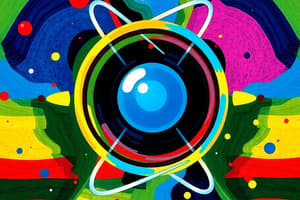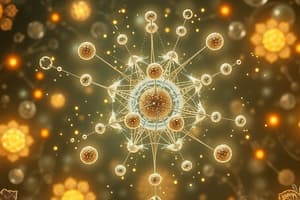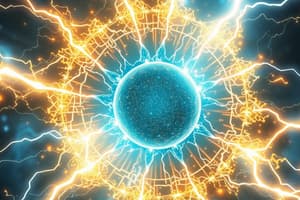Podcast
Questions and Answers
What is matter defined as?
What is matter defined as?
- Only solid substances in the universe
- A substance that cannot change form
- Everything that occupies space and has weight (correct)
- Elements that are chemically combined
Which of the following best describes an element?
Which of the following best describes an element?
- The smallest particle in the universe
- A single substance that cannot be reduced further (correct)
- A combination of two or more compounds
- A substance that can be reduced to simpler forms
How many known elements exist?
How many known elements exist?
- Exactly 100
- More than 100 (correct)
- Less than 50
- Only 10
What distinguishes one atom from another?
What distinguishes one atom from another?
What are the three primary types of sub-atomic particles in an atom?
What are the three primary types of sub-atomic particles in an atom?
What forms a compound?
What forms a compound?
How is the diversity of matter similar to constructing words?
How is the diversity of matter similar to constructing words?
What might lead to confusion about atoms and elements?
What might lead to confusion about atoms and elements?
Flashcards are hidden until you start studying
Study Notes
Matter and Elements
- Matter is defined as anything that occupies space and has weight; examples include air, water, clothing, animals, and the human body.
- Matter exists in three primary states: solid, liquid, and gaseous.
- An element is a pure substance that cannot be simplified further; examples are gold, silver, oxygen, and iron.
- There are over 100 known elements, and all compounds are formed by the chemical combination of one or more elements.
- Common compounds include salt (sodium + chlorine) and water (hydrogen + oxygen).
- An atom is the smallest particle that retains the characteristics of an element.
- Atoms of different elements possess distinct characteristics, leading to the vast diversity in matter.
Diversity of Matter
- Similar to how letters combine to form different words, atoms combine in various ways to create a multitude of substances.
- The interaction and combination of over 100 elements account for the diverse forms of solid, liquid, and gaseous matter in the environment.
Structure of the Atom
- Atoms consist of three subatomic particles: electrons, protons, and neutrons.
- Electrons are negatively charged, protons are positively charged, and neutrons carry no charge.
- In certain atoms, neutrons may not be present, particularly in hydrogen.
- The identity of an atom is determined by the number and arrangement of its subatomic particles.
- The variation in the number of subatomic particles distinguishes one element from another.
Studying That Suits You
Use AI to generate personalized quizzes and flashcards to suit your learning preferences.




